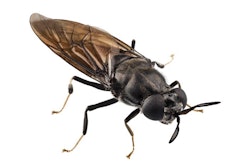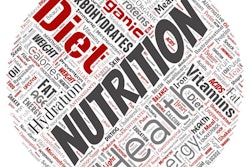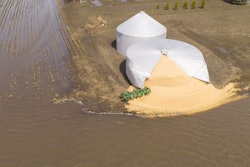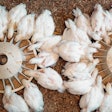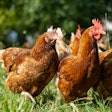
From retailer pressures to new technologies, numerous factors are helping the feed sector embrace sustainability.
The critical sustainability issues affecting the animal feed industry came under the spotlight at the 2022 European LIVE Feed Congress, co-located at VIV Europe, Utrecht, The Netherlands, on May 30.
Meat demand changing
Coen Smits, director of sustainability, Trouw Nutrition, noted that the world population will rise to 10 billion by 2050, meaning that food production must double, and low-income countries will see the most growth. Over recent decades, the population explosion has been concentrated in Asia, but Africa will become the leader in years to come.
This will result in greater demand for animal protein and, he noted, milk and poultry production are forecast to grow the most, by 22% and 17% respectively, between 2020 and 2030. Looking specifically at Europe, he noted that while poultry production has grown more than any other animal protein over the past decade, expansion in the sector will only be slight over the next decade.
Where feed is concerned, production has risen over the past 30 years to stand at 165 million metric tons. However, it can be expected to decline as Europe undergoes a transition from traditional meat proteins to alternatives, included cultured and plant-based meats.
While these alternatives will still only account for a small part of the market by 2055, the segment is growing fast.
Alternatives, however, are not the only factor affecting feed production in Europe. The European Union will be climate neutral by 2050, and there are 2030 targets for sustainable food production. The EU’s Green Deal, for example, could lead to lower agricultural yields. If crop production is reduced, there will be less available for feed.
Local environmental rules also have an impact. The Netherlands, for example, is likely to reduce the number of animals reared to offset nitrogen produced in other areas.
Smits argued that there needs to be a better understanding of the benefits of feed production. According to the FAO, he said, 86% of livestock feed cannot be used in human diets. In many ways, this makes the feed industry quite sustainable, as it uses inputs that cannot be used in human nutrition.
While regional feed industries can make a difference to food production’s sustainability, broader adoption of certain initiatives, such as that for sustainable soy, would make a bigger differences.
And there are numerous areas where new efforts can be made. Phytase is used to reduce nitrogen and phosphorous excretion, but greater use of multiphase feeding and precision nutrition would also help in this regard.
Animals are still performing below their genetic potential, so there is still room for improvement. Early life nutrition must be optimized.
How and where to analyze
Pierre-Joseph Paoli, president – feed additives and ingredients, ADM Animal Nutrition, examined the environmental impact of feed additives and ingredients, from the extraction of raw materials through processing, transport, use and disposal.
He explained that, in a lifecycle assessment, definitive goals need to be set, scope needs to be decided – should upstream and downstream be considered, for example – and results need to be interpreted. How analysis is carried out will affect what can be done with the information.
He gave the example of an analysis of a feed additive used in a broiler diet. The poultry diet’s upstream emissions were moderate to relatively low. Manufacturing the additive resulted in moderate emissions, but use of the additive resulted in a saving in downstream Scope 3 emissions.
Can’t improve what you don’t measure
David Nickell, vice president – sustainability and business solutions with DSM Animal Nutrition and Health, focused on how feed, feed formulations, feed additives and sourcing can be leveraged to meet a corporation’s sustainability goals, improve production and sustainability, and result in upstream returns.
Consumers, he said, can make a significant contribution to reducing carbon emissions through their food choices. Surveys across countries have found that consumers want on-the-package sustainability information and will pay more for sustainably produced food. Over the next couple of years, sustainability labels are expected to be increasingly common.
If animal production continues without change, it will consume an increasing proportion of the resources, and while a lot of attention is paid to feeding the world, less is paid to manure and its effect on water.
Retailers are increasingly signing up to science-based targets and, as they add accountability and credibility, they are raising awareness and looking right into the farms of their suppliers. Retailers are not alone, and the financial industry is also heading toward net zero, while some investor groups are naming and shaming.
Feed has a big impact when it comes to environmental footprint and, when looking at footprint, it is essential to have a full ecosystem approach, with accurate footprint measurement. If, for example, only carbon emissions are considered, other areas may be ignored.
Improvements can only be made after proper measurement, but once a footprint has been established, improvements can be made, helping to elevate brands and enabling new retail opportunities to be exploited.
Insects in feed
The global insect industry is already worth US$1 billion globally and is set to be one of the world’s fastest growing industries.
Dr. Graeme Dear, non-executive director, Beta Bugs Ltd., echoed previous speakers that the world needs more protein and that much will come from animals and that these animals must, somehow, be fed.
Insects, he said, should be a marketer’s dream for the fish, poultry, pig and pet sectors.
The biggest challenge for the sector remains cost and scale of production, but this can be achieved.
The industry offers local production, using locally derived feedstocks. It offers opportunities for small producers, selling on to processors, or perhaps following the broiler production model.
While insects may never replace soy, he said, their use could reduce the land needed for soy production.



